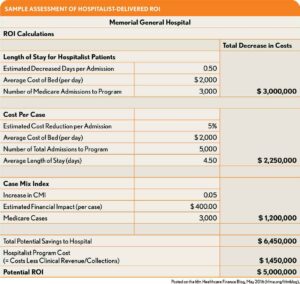
6 Hospital Medicine ROI Value Drivers
Home » 6 Hospital Medicine ROI Value Drivers
6 Hospital Medicine ROI Value Drivers
Home » 6 Hospital Medicine ROI Value Drivers
Home » 6 Hospital Medicine ROI Value Drivers
Home » 6 Hospital Medicine ROI Value Drivers
As Medicare payment dependency on performance metrics increases, hospital administrators are being forced to take a microscopic look at the costs of supporting clinical service lines regarding both patient care and ROI.
As a hospitalist, you manage a large percentage of all medical and surgical patients and, therefore, play a key role in determining whether the hospital will avoid penalties or, in the case of value-based purchasing, earn bonus dollars.
In this post, we discuss six HM program economic and behavioral value drivers you can put into action to improve patient outcomes and significantly impact ROI.
Emergency and Hospital Medicine programs function best when they work together.
When aligned, the two programs improve patient care quality, efficiency, performance, and satisfaction. Also, by working closely to manage patients admitted by the ED, hospitals see improvements in metrics that improve patient care, including:
When the two programs are at odds, however, their conflict has a ripple effect that increases cost, affects patient experience, patient safety, and physician satisfaction, and compromises care consistency.
For that reason, make it your priority to optimize EM-HM transitions of care by keeping lines of communication open and agreeing on process standards, mutual goals, accountability, and objective data measures.
By capturing the severity of a patient’s illness — documenting the complications and comorbidities that accompany a diagnosis — you ensure that you assign the correct Diagnosis-Related Grouping (DRG) to a patient, ultimately prompting a more accurate (and improved) case mix index (CMI).
There are at least three reasons why this is important:
You can reduce the cost per case through efficient rounding practices and resource utilization. This includes appropriately focused lab tests and consultations, writing only clinically appropriate orders, and using medications listed on the hospital’s formularies when possible.
Medicare payment for services rendered is dependent on improved clinical quality through attention to CMS’s value-based programs. Effectively managing your HM program enables you to maximize performance on measures that reflect quality metrics.
Your goal should be to document improved efficiency, outcomes, and patient experience, while minimizing hospital-acquired conditions, mortality, and readmissions.
The best way hospitals can improve their bottom line is by making beds available to admit additional patients. Patients who spend avoidable days in the hospital awaiting discharge require staffing and pharmaceutical resources while being exposed to preventable harm.
It is essential, then, that you manage patients well and discharge them as soon as there is no longer a clinical need for that bed.
Improving LOS not only requires the efficient ordering of tests, strategic use of consultants and specialists, and effective patient management but also the foresight to anticipate a patient’s discharge needs upon admission.
By assessing the patient’s probable discharge needs upon admission and working with case management, physical and occupational therapy, and nutrition, you can begin preparations to send the patient safely home with appropriate services or to a post-acute care setting at the outset.
By utilizing these six value drivers, your HM program can improve patient care and impact hospital profitability in ways you may never have imagined. By focusing on the quality and outcomes the value drivers promote, you offer a clear ROI for your hospital while also creating loyalty and satisfaction for patients and physicians alike.
To learn more about ways to increase HM program ROI, download the whitepaper “Maximizing Hospital Medicine ROI: Strategies to Optimize Your HM Program.”

Sign up for our newsletter to receive the latest updates and exclusive content straight to your inbox.

A physician-led team of clinical specialists in emergency, hospital, and critical care medicine, supporting local clinical practices with national resources to deliver high-quality patient care in the communities we serve.
Corporate Phone: (800) 893-9698
Copyright © 2025. All rights reserved.
Please visit SCP Health’s Insurance Request Portal to submit requests related to medical malpractice liability insurance such as coverage verifications, claims history reports, and certificates of insurance. If you experience issues with the portal submission or have a question about the process, please reach out SCP Health’s Risk Management, Safety and Insurance Department at RM@scphealth.com or 337-609-1250.
By clicking the “Submit” button, you are agreeing to the SCP Heath Terms of Use and Privacy Policy
By clicking the “Submit” button, you are agreeing to the SCP Heath Terms of Use and Privacy Policy
By clicking the “Submit” button, you are agreeing to the SCP Heath Terms of Use and Privacy Policy
By clicking the “Submit” button, you are agreeing to the SCP Heath Terms of Use and Privacy Policy
By clicking the “Submit” button, you are agreeing to the SCP Heath Terms of Use and Privacy Policy
By clicking the “Submit” button, you are agreeing to the SCP Heath Terms of Use and Privacy Policy
By clicking the “Submit” button, you are agreeing to the SCP Heath Terms of Use and Privacy Policy
By clicking the “Submit” button, you are agreeing to the SCP Heath Terms of Use and Privacy Policy
By clicking the “Submit” button, you are agreeing to the SCP Heath Terms of Use and Privacy Policy
By clicking the “Submit” button, you are agreeing to the SCP Heath Terms of Use and Privacy Policy
Please provide your contact information. An SCP representative will contact you accordingly.